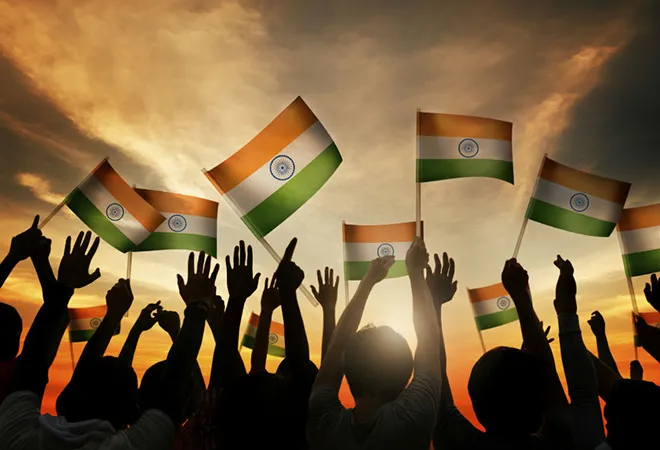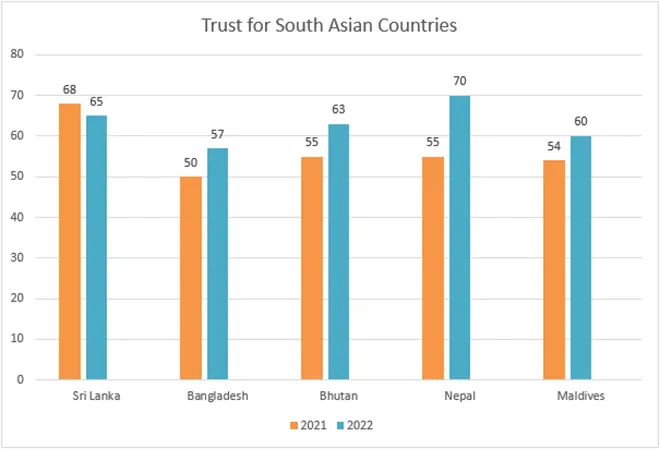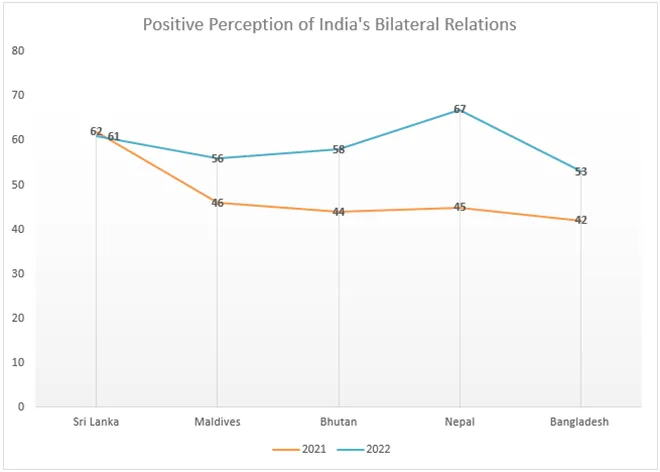
India’s complex history, politics, size, and military power have often fuelled suspicions and reservations on New Delhi across the region. The promotion of democracy throughout South Asia has only further exacerbated this
phenomenon. While the causes for such reservations have been well-researched, there is very little written about Indian civil society’s perception of its neighbourhood. The
second edition of the ORF Foreign Policy Survey provides some important insights in this regard. Launched in November 2022, the survey consists of a sample of 5,000 Indian youth between the ages of 18 to 35, from over 19 different cities.
For Indian youth, South Asia (36 percent) is the most strategically important region—largely outweighing other important regions of Southeast Asia, Central Asia, and the Indo-Pacific. South Asia continues to be seen as a region crucial to India’s sphere of influence and strategic relevance. This relevance is further supported by the calls for regional institutionalisation—as 72 percent of the respondents favoured the revival of the South Asian Association for Regional Cooperation (SAARC).
An adequate neighbourhood policy?
A majority of the Indian youth (79 percent) believe that the Indian neighbourhood policy or ‘Neighbourhood First’ policy has been adequately defined; and has largely been adequate in the sectors of trade (86 percent), security (81 percent), people-to-people contacts (79 percent), cultural ties (75 percent), infrastructure and connectivity (71 percent), and political engagement (68 percent). A closer assessment of cities of Indian states bordering South Asian countries provides an additional in-depth analysis (refer to Table
1).
| Sector |
Chennai
(adequacy %) |
Dehradun
(adequacy %) |
Guwahati
(adequacy %) |
Kolkata
(adequacy %) |
Lucknow
(adequacy %) |
Patna
(adequacy %) |
| Trade |
84 |
90 |
88 |
80 |
89 |
91 |
| Security |
78 |
83 |
89 |
80 |
86 |
85 |
| Political engagement |
44 |
72 |
79 |
68 |
79 |
76 |
| Cultural ties |
69 |
79 |
81 |
76 |
82 |
86 |
| People-to-people contacts |
80 |
82 |
85 |
84 |
83 |
86 |
| Infrastructure and connectivity |
67 |
77 |
84 |
67 |
82 |
84 |
Table 1. Adequacy of India’s neighbourhood policy, perceptions from cities of bordering states
Respondents throughout India have displayed satisfaction with the level of people-to-people contacts and trade with India’s neighbours, in contrast with counterparts who have often
criticised India for sustaining a trade deficit. In a region that is vulnerable to the spillover impacts of insurgency, civil wars, and terrorism, youth across the nation believe that India and its neighbours are adequately cooperating on security.
Respondents from Chennai have indicated the dearth of political engagement, infrastructure and connectivity, and cultural ties—indicating the need for more holistic engagement between Tamil Nadu and Sri Lanka. Responses from Kolkata also indicate the need for more infrastructure and connectivity and political engagement with the neighbouring countries of Bhutan, Nepal, and Bangladesh.
Positive perception and the rationale
Most of the Indian youth view smaller South Asian countries—Sri Lanka, Maldives, Bhutan, Nepal, and Bangladesh—positively. A comparison of responses for trust and bilateral relations from the
2021 and 2022 editions of the survey substantiates this argument further (Refer Graph 1 & Graph 2). The latest survey indicates an increase in positive perception for these countries, except for Sri Lanka, where there is a 3-percent decline in trust and a 1-percent decline in the perception of positive bilateral relations.
 Graph 1: Trust for South Asian Countries
Graph 1: Trust for South Asian Countries
 Graph 2: Positive perception of South Asian countries
Graph 2: Positive perception of South Asian countries
This outcome indicates four important observations: First, geopolitical developments alone do not impact how Indian youth perceive their neighbours. The Rajapaksas’ pro-China tilt till 2021 and India’s assistance to Sri Lanka in 2022 during the crisis; Bhutan’s MoU signing with China in 2021; Maldives’ ‘India First’ policy since late 2018; and Bangladesh’s pro-India policy and occasional balancing with China—have had no significant impact on the youth’s perception.
Media coverage plays a reasonable role in shaping the perception. KP Oli’s anti-India policy and the Lipulekh stand-off triggered Indian media’s
negative coverage of Nepal in 2020—likely contributing to a pessimistic perception of the country in the 2021 Survey. The decrease in negative coverage due to a regime change and improvement in bilateral relations has likely contributed to positive perception, as indicated by this year’s survey. Fewer media coverage for countries that are friendly to India, such as Bhutan and the Maldives, and
conflicting media coverage for Bangladesh has also likely limited the positive perception.
The decrease in negative coverage due to a regime change and improvement in bilateral relations has likely contributed to positive perception, as indicated by this year’s survey.
Third, historical interactions and robust people-to-people relations have a lasting impact on how Indians perceive their neighbours. Essentially, even in 2021, more than half of the respondents trusted and had a positive perception of Nepal and Sri Lanka despite their pro-China tilt.
Finally, the overall Indian perception is largely immune to certain identity, ethnic, and political tensions between bordering Indian states and their neighbours. While politicians and media sections from neighbouring countries largely use
anti-India sentiments to muster nationalist sentiments and further their political gains, this is less plausible in India due to its complex ethnic composition, size, and federal and domestic structure. For instance, only respondents from Guwahati and Chennai had less trust and positive perceptions of Bangladesh and Sri Lanka (refer to Table 2), while others opined otherwise.
| Indian City |
Neighbour |
Trust (%) |
Positive perception of Bilateral relations (%) |
| Kolkata |
Bhutan |
76 |
63 |
| Guwahati |
Bhutan |
87 |
87 |
| Kolkata |
Bangladesh |
76 |
70 |
| Guwahati |
Bangladesh |
41 |
44 |
| Dehradun |
Nepal |
62 |
57 |
| Kolkata |
Nepal |
73 |
66 |
| Lucknow |
Nepal |
80 |
75 |
| Patna |
Nepal |
87 |
87 |
| Chennai |
Sri Lanka |
47 |
45 |
Table 2. Trust and Positive perception for neighbours, perceptions from cities of bordering states
The strategic challenge: Afghanistan, Pakistan, China, and beyond
Indian youth’s perception of Afghanistan and Pakistan is very different from that of other South Asian countries. This is attributed to the fact that the youth (86 percent) see terrorism as a major foreign policy challenge to the country.
While India enjoys
significant goodwill in Afghanistan, the same cannot be said for Afghanistan in India. In 2021, only 42 percent of Indian youth trusted Afghanistan; over 34 percent believed that India had good bilateral relations with them. The negative perception of Afghanistan has increased even more with the Taliban’s takeover in August 2021. In 2022, only 33 percent trusted Afghanistan, and only 29 percent expressed optimism for India-Afghan relations. While the majority (68 percent) of the respondents have backed India’s recent Afghanistan policy, fewer respondents (37 percent) believed that engaging with the Taliban could help India protect its interests.
Over 58 percent of youth opined that India’s policy of not engaging with Pakistan is beneficial to regional peace and stability, in tandem with India’s policy to isolate Pakistan on the international stage.
Indian youth have also remained pessimistic about Pakistan. Nearly 78 percent expressed distrust for Pakistan; 74 percent believed that India’s bilateral relations with Islamabad are poor. Over 58 percent of youth opined that India’s policy of not engaging with Pakistan is beneficial to regional peace and stability, in tandem with India’s
policy to isolate Pakistan on the international stage. Similar to the Indian strategic thinking—Beijing is now being seen as a
bigger threat by the Indian youth. Respondents are more concerned (84 percent) about border clashes with China than with Pakistan (82 percent).
The youth have displayed a trust deficit and suspicion for Beijing throughout the survey. Although they do not perceive the neighbourhood as a zero-sum game between India and China, over 71 percent of the respondents believe that China is a threat to India’s global rise, and 82 percent believe that China is a threat to Indian borders.
But, with 83 percent of the respondents opining that the United States’ support will be crucial for India’s rise and seeing other Quad members such as Australia (78 percent) and Japan (73 percent) as India’s most crucial partners for the future—the youth are likely to be more accommodative and supportive of India and its partners in the neighbourhood. Indian youth are thus embracing and displaying a
sophisticated understanding of the new world order in which South Asia plays a crucial part.
The views expressed above belong to the author(s). ORF research and analyses now available on Telegram! Click here to access our curated content — blogs, longforms and interviews.



 India’s complex history, politics, size, and military power have often fuelled suspicions and reservations on New Delhi across the region. The promotion of democracy throughout South Asia has only further exacerbated this
India’s complex history, politics, size, and military power have often fuelled suspicions and reservations on New Delhi across the region. The promotion of democracy throughout South Asia has only further exacerbated this 

 PREV
PREV



